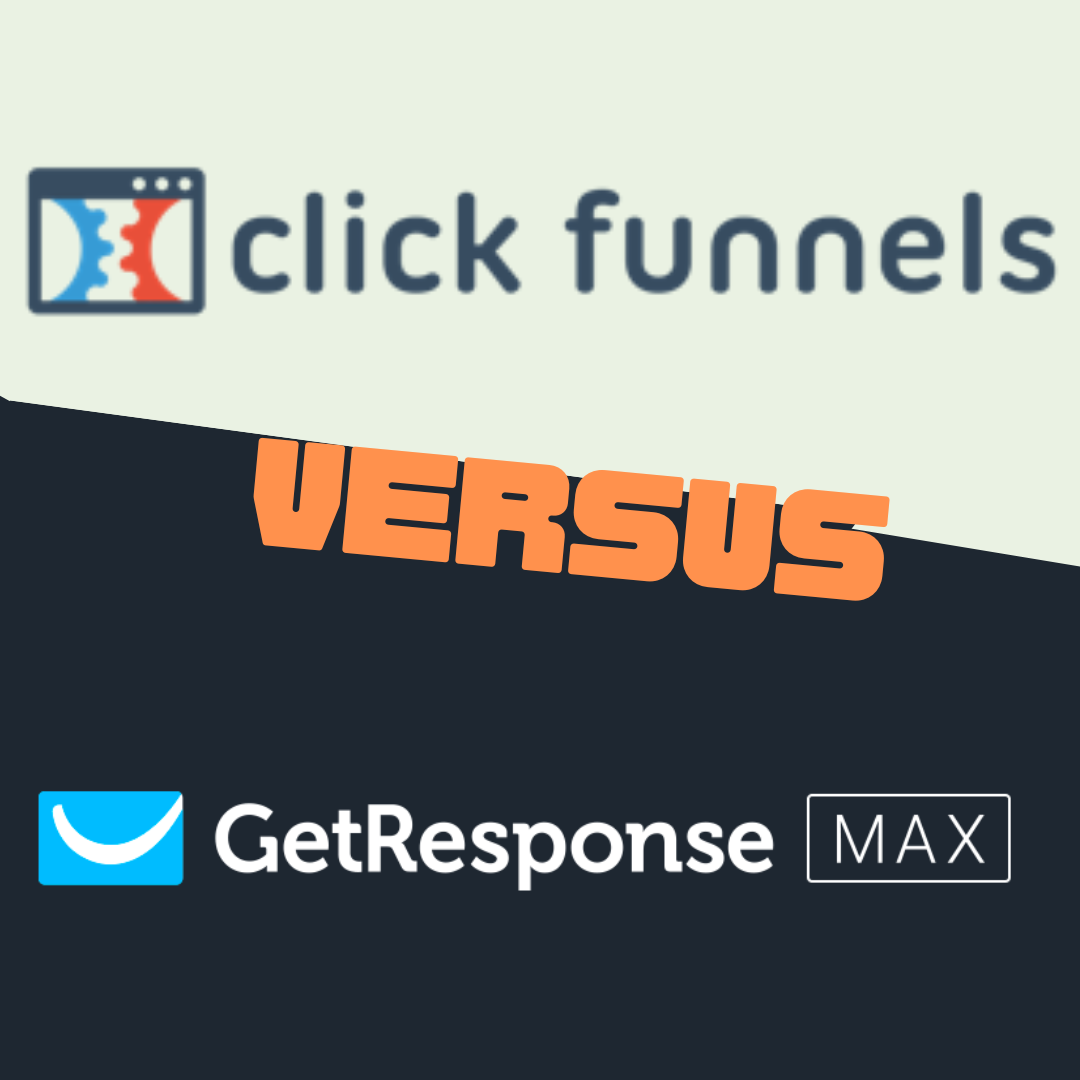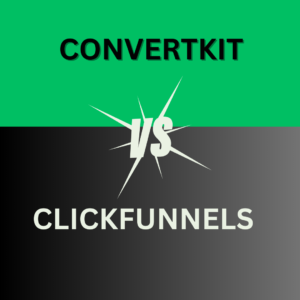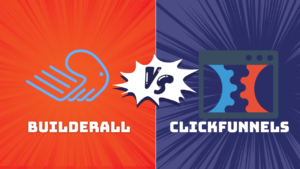When it comes to choosing between ClickFunnels vs GetResponse for your digital marketing needs, making an informed decision is crucial for maximizing your online strategy’s effectiveness. Both platforms offer robust features designed to streamline marketing workflows, increase engagement, and boost conversions.
Whether you’re a digital marketing veteran or just starting, understanding the key differences and strengths of ClickFunnels and GetResponse can significantly impact your business’s success. This blog post will explore these platforms across several vital aspects, including ease of use, template and design options, email marketing capabilities, sales funnel creation and management, integration capabilities, analytics and reporting, and compliance and security. Our goal is to provide a comprehensive comparison to help you decide which platform—ClickFunnels or GetResponse—is the best fit for your digital marketing strategy. Join us as we delve into the specifics of each tool, offering insights that could unlock new growth opportunities for your business.
Table of Contents
ClickFunnels vs GetResponse – Round 1 :Overview and Core Features
When comparing ClickFunnels vs GetResponse, it’s essential to start by understanding the core features and fundamental differences between these two powerful platforms. Both tools are designed to enhance online marketing efforts but serve slightly different purposes at their core.
ClickFunnels is primarily a sales funnel builder designed to help businesses automate their sales process from start to finish. It simplifies the process of creating and managing sales funnels, making it easier for users to guide potential customers through the buying journey. The core features of ClickFunnels include drag-and-drop webpage editors, funnel templates for various marketing goals (e.g., lead generation, sales, events), A/B testing capabilities, and integration with numerous third-party applications. Its focus is on making it as easy as possible for entrepreneurs and businesses to design marketing funnels that convert visitors into leads and customers.
GetResponse, on the other hand, is a comprehensive email marketing platform that offers a broader range of features beyond email campaigns. These include autoresponders, email analytics, landing pages, and webinar hosting. More recently, GetResponse has expanded its offerings to include marketing automation, CRM functionality, and ecommerce features, making it a versatile tool for managing a wide range of online marketing activities. While GetResponse does offer funnel building capabilities (with its Autofunnel feature), its strength lies in its email marketing and automation tools.
ClickFunnels vs GetResponse – Round 2 : Pricing and Value for Money
In evaluating ClickFunnels vs GetResponse, understanding the pricing structures and the value each platform offers for its cost is essential for businesses looking to make the most out of their marketing budget. Both platforms offer a range of pricing options designed to cater to different needs, from small businesses to larger enterprises.
ClickFunnels offers several pricing tiers, starting with a basic plan that includes access to the funnel builder, a selection of templates, and basic integration options. Higher-tier plans provide additional features such as advanced funnels, A/B testing, more integration capabilities, and access to the ClickFunnels training and support community. While ClickFunnels might appear to be on the pricier side, its value proposition lies in the comprehensive suite of tools it provides for creating and optimizing sales funnels, making it a potentially invaluable investment for businesses focused on funnel-driven sales strategies.
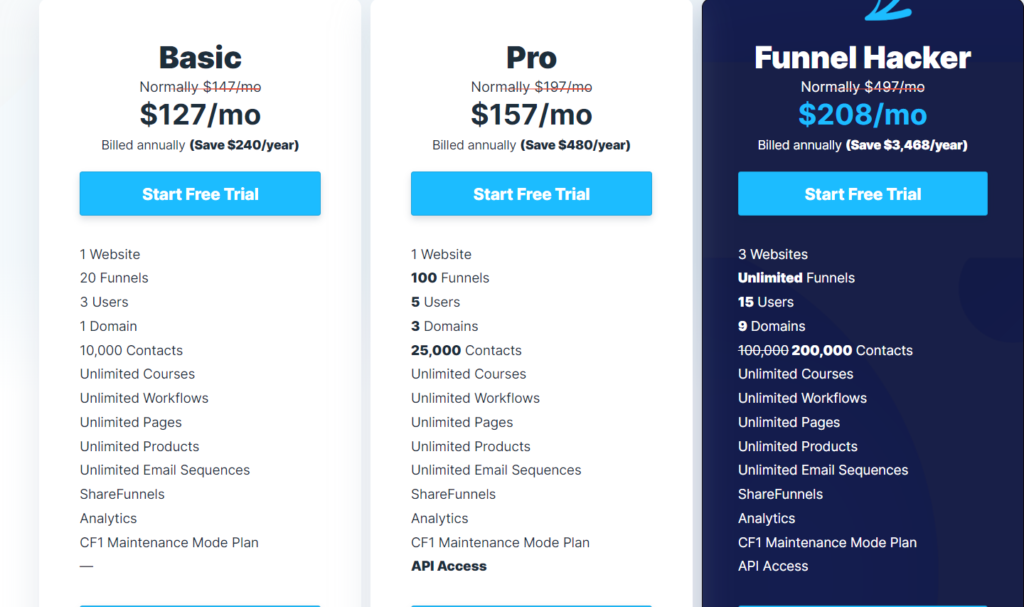
GetResponse, traditionally known for its email marketing services, provides a more varied pricing model that scales with the size of your email list. Starting with a basic plan that includes email marketing, autoresponders, and a landing page builder, GetResponse also offers more advanced plans that incorporate automation, webinars, and CRM functionality. The platform’s pricing is competitive, especially considering the breadth of features it offers beyond email marketing, such as comprehensive automation and analytics, making it a cost-effective choice for businesses looking to execute a multi-channel digital marketing strategy.
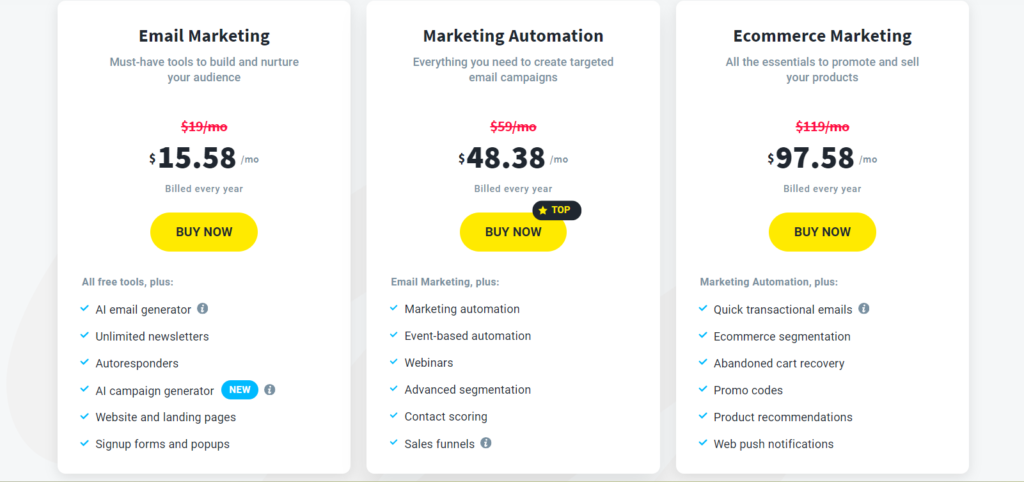
ClickFunnels vs GetResponse – Round 3 Ease of Use
When comparing ClickFunnels vs GetResponse in terms of ease of use, it’s clear that both platforms have invested significantly in creating user-friendly interfaces that cater to both beginners and advanced users. However, their approaches to user experience and interface design have some differences that might influence your choice depending on your preferences and technical expertise.
ClickFunnels prides itself on a straightforward, drag-and-drop editor that allows users to create sales funnels without any coding knowledge. This platform is designed with the entrepreneur in mind, focusing on simplicity and efficiency. Users can easily select templates and customize them according to their needs, making it possible to get a funnel up and running in a matter of minutes. The intuitive nature of the ClickFunnels interface means that new users can quickly become proficient, focusing more on strategy and less on the technical aspects of funnel building.
GetResponse also features a user-friendly design, particularly in its email editor and landing page builder. Like ClickFunnels, it offers a drag-and-drop interface, making it accessible to those without a background in web design or coding. Additionally, GetResponse provides a wide range of pre-designed templates for emails, landing pages, and automation flows, allowing users to create professional-looking campaigns with ease. The platform’s layout is clean and organized, ensuring that even new users can find their way around without too much trouble.
In essence, both ClickFunnels and GetResponse offer environments that are easy to navigate and utilize, even for those who are not technically inclined. The choice between them may come down to whether your primary focus is on creating sales funnels or executing broad digital marketing campaigns that include email marketing, automation, and beyond. Each platform’s commitment to ease of use ensures that marketers can concentrate on crafting compelling content and strategies, rather than getting bogged down by complex software logistics.
ClickFunnels vs GetResponse – Round 4 Template and Design Options
In the comparison of ClickFunnels vs GetResponse, the variety and quality of template and design options play a crucial role for businesses aiming to create compelling, high-converting marketing materials. Both platforms offer a wealth of templates and design tools, but they cater to slightly different needs and preferences.
ClickFunnels focuses on providing a wide array of funnel templates specifically designed for various marketing objectives, such as lead generation, sales, webinars, and membership sites. These templates are not only visually appealing but also optimized for conversion, incorporating elements that are known to encourage user action. Users can easily customize templates using the platform’s drag-and-drop editor, allowing for a high degree of personalization without the need for coding skills. The emphasis is on functional design that drives results, with a range of styles to match different brand identities.
GetResponse, while also offering a significant selection of templates, shines particularly in the realm of email marketing and landing pages. Its templates are designed to cater to a broad spectrum of email campaigns and landing page objectives, from promoting sales to distributing newsletters. The design options in GetResponse are highly customizable, enabling users to create cohesive, brand-aligned marketing materials. Additionally, GetResponse’s templates are responsive, ensuring that emails and landing pages look great on any device, which is essential for engaging today’s mobile-centric audiences.
ClickFunnels vs GetResponse – Round 5 Email Marketing Capabilities
When it comes to email marketing capabilities, the comparison of ClickFunnels vs GetResponse reveals significant differences in focus and functionality, given the unique strengths of each platform. Understanding these capabilities is essential for businesses looking to engage their audience through targeted, effective email campaigns.
ClickFunnels integrates email marketing features primarily through its follow-up funnels (previously known as Actionetics), which is part of its more advanced plans. This feature allows users to create and send automated email sequences based on user actions within the sales funnel. Although not as comprehensive as dedicated email marketing platforms, ClickFunnels’ email functionality is designed to complement its sales funnel architecture, enabling users to nurture leads directly within the ecosystem of their funnels. The emphasis is on simplicity and direct integration, ensuring that users can manage their email campaigns without needing to leave the ClickFunnels environment.
GetResponse, in contrast, is renowned for its robust email marketing capabilities. As a platform that started with email marketing, GetResponse offers a wide array of features including advanced automation, segmentation, A/B testing, and detailed analytics. Users can design highly personalized email campaigns using a drag-and-drop editor, and benefit from a vast library of responsive email templates. GetResponse’s strength lies in its detailed targeting options and the ability to create complex automation workflows that trigger emails based on specific user behaviors, making it a powerful tool for businesses focused on maximizing engagement through email.
ClickFunnels vs GetResponse – Round 7 Sales Funnel Creation and Management
The comparison between ClickFunnels vs GetResponse in this domain highlights each platform’s approach to simplifying the sales process through automation and strategic funnel design.
ClickFunnels is specifically designed with sales funnel creation and management at its core. It offers a user-friendly platform that enables marketers and business owners to build custom funnels for various purposes, such as lead generation, product sales, and event registrations. ClickFunnels simplifies the process with drag-and-drop functionality, a wide array of pre-designed funnel templates, and integrated A/B testing to optimize for conversions. The platform’s strength lies in its focus on funnel efficiency, guiding users from the initial setup to the optimization phase with ease. ClickFunnels also allows for integration with payment gateways, email marketing tools, and other essential services, making it a comprehensive tool for managing all aspects of a sales funnel.

GetResponse has expanded its offerings beyond email marketing to include sales funnel capabilities, particularly with its Autofunnel feature. This addition enables users to create complete funnels for sales, leads, and webinars directly within the platform. While GetResponse’s funnel creation tools are not as extensive as ClickFunnels, they are integrated with its robust email marketing and automation features, providing a seamless experience for managing email sequences within the funnel. GetResponse’s funnels are easy to set up and come with the added benefit of access to its landing page builder and analytics, making it a versatile choice for businesses that also prioritize email marketing.
In essence, ClickFunnels excels in the niche of sales funnel creation and management, offering a dedicated platform that caters specifically to building and optimizing various types of sales funnels. GetResponse, while providing valuable funnel creation tools, integrates these capabilities within a broader suite of marketing features, making it ideal for those who want an all-in-one solution that includes strong email marketing capabilities. Choosing between ClickFunnels vs GetResponse for sales funnel creation and management will depend on your specific needs, whether you’re looking for a specialized tool or a comprehensive marketing platform.
ClickFunnels vs GetResponse – Round 8 Integration Capabilities
When comparing ClickFunnels vs GetResponse in terms of integration capabilities, it’s important to understand how each platform connects with external services and applications to enhance its core offerings.
ClickFunnels offers a robust set of integration options that cater to various aspects of the online business landscape. It seamlessly connects with major email marketing platforms, payment gateways (such as Stripe, PayPal, and others), webinar platforms, and even CRM systems. This wide range of integrations allows users to create a cohesive system where data and processes flow smoothly between ClickFunnels and other essential tools. For businesses that rely on a diverse set of applications to manage their operations, ClickFunnels’ integration capabilities ensure that sales funnels are a central part of an interconnected marketing strategy.
GetResponse, on the other hand, also boasts impressive integration capabilities, particularly with its strong emphasis on email marketing and automation. Beyond the typical email service providers, GetResponse integrates with popular e-commerce platforms, CRM software, social media tools, and landing page builders. This extensive integration ecosystem enables users to automate their email marketing campaigns, synchronize customer data, and track interactions across multiple channels from a single platform. For marketers focusing on comprehensive digital marketing campaigns that include email automation, social media, and e-commerce, GetResponse provides the necessary tools to create a unified marketing environment.
ClickFunnels vs GetResponse – Round 9 Analytics and Reporting
Understanding the performance of your marketing campaigns is crucial for making data-driven decisions, and the analytics and reporting features of any platform play a pivotal role in this process. When comparing ClickFunnels vs GetResponse in terms of analytics and reporting, it’s essential to dive into how each platform helps users measure success and optimize their strategies accordingly.
ClickFunnels provides users with comprehensive analytics for each step of their sales funnels. This includes detailed reports on page views, opt-in rates, conversion rates, and sales metrics. The platform’s dashboard presents these analytics in a clear, easy-to-understand format, allowing users to quickly identify which areas of their funnels are performing well and which need improvement. ClickFunnels emphasizes conversion-related metrics, giving users valuable insights into how effectively their funnels are generating leads and sales. This focus on funnel performance analytics is crucial for businesses looking to refine their sales processes and increase ROI.
GetResponse, with its broad focus on email marketing and automation, offers a wide range of analytics features tailored to various aspects of digital marketing campaigns. This includes email campaign performance (open rates, click-through rates, etc.), landing page conversion rates, and webinar attendance statistics, among others. GetResponse’s analytics dashboard provides a detailed overview of campaign performance across channels, enabling users to assess the effectiveness of their marketing efforts comprehensively. Additionally, the platform offers advanced segmentation and analytics features, allowing marketers to drill down into specific data segments for more targeted analysis and optimization.
ClickFunnels vs GetResponse – Round 10 E-commerce Features
For businesses looking to sell products and services online, the e-commerce capabilities of their chosen marketing platform can significantly impact their ability to generate revenue and provide a seamless customer experience. When evaluating ClickFunnels vs GetResponse for e-commerce features, it’s important to consider how each platform supports online sales, from product listings to payment processing.
ClickFunnels excels in creating sales funnels that are optimized for conversions, making it a powerful tool for e-commerce businesses. It allows users to design and implement custom sales funnels that guide customers through the buying process, from initial interest to final purchase. Key e-commerce features include one-click upsells, order bumps, and shopping cart functionality, which can significantly increase the average order value. Additionally, ClickFunnels integrates with major payment gateways like Stripe, PayPal, and others, facilitating secure and efficient transactions. The platform also offers capabilities for selling digital products, memberships, and subscriptions, providing flexibility for a wide range of online business models.
GetResponse, traditionally known for its email marketing capabilities, has broadened its feature set to include robust e-commerce solutions, particularly through integrations with platforms like Shopify. This integration allows users to bring their product listings into GetResponse and create targeted marketing campaigns, landing pages, and automation workflows based on customer data and behaviors. Additionally, GetResponse’s Autofunnel feature provides ready-made sales funnels for products, including everything from promotional landing pages to payment processing with integrated e-commerce services. This makes it easier for users to set up and manage their online sales processes within a comprehensive marketing framework.
ClickFunnels vs GetResponse – Round 11 Customer Support and Community
Effective customer support and a vibrant community are invaluable resources for users navigating the complexities of digital marketing platforms. When comparing ClickFunnels vs GetResponse in terms of customer support and community, it’s important to consider the availability, quality of support, and the presence of an active user base that can offer peer-to-peer advice and insights.
ClickFunnels is renowned for its dedicated customer support and extensive community engagement. Users have access to a range of support options, including live chat, email support, and a vast knowledge base filled with helpful articles, guides, and video tutorials. ClickFunnels also boasts a vibrant community, particularly within its official Facebook group, where users can share experiences, strategies, and success stories. This community acts as an additional layer of support, offering real-world advice and encouragement from fellow users. The platform frequently hosts webinars and events, further fostering a sense of community and providing users with learning opportunities.
GetResponse offers a comprehensive support system as well, with 24/7 live chat, email support, and phone support available to users. The platform provides a rich library of resources, including tutorials, FAQs, and video guides, designed to help users maximize their use of the platform. GetResponse’s community is active in online forums and social media, offering a space for discussion and exchange of ideas. The company also conducts webinars and online courses through GetResponse University, providing in-depth training on various aspects of digital marketing and platform usage.
In summary, both ClickFunnels and GetResponse excel in providing robust customer support and fostering active communities. ClickFunnels stands out for its highly engaged user community and frequent interactive events, making it an excellent choice for those looking to immerse themselves in a dynamic learning environment. GetResponse, with its round-the-clock support and extensive educational resources, ensures that users have the knowledge and assistance they need to succeed. The decision between ClickFunnels vs GetResponse may come down to the type of support and community engagement you value most for your business’s growth and success.
ClickFunnels vs GetResponse – Final Round Compliance and Security
In today’s digital landscape, compliance and security are paramount concerns for businesses of all sizes. Ensuring that your marketing tools adhere to global regulations and protect sensitive customer data is critical. When evaluating ClickFunnels vs GetResponse on compliance and security, it’s essential to consider how each platform addresses these concerns, providing peace of mind for businesses and their customers.
ClickFunnels takes security and compliance seriously, implementing various measures to protect user data and ensure that the platform is in line with industry standards and regulations. This includes compliance with the General Data Protection Regulation (GDPR) for European users, providing features like data processing agreements and cookie consent prompts to help users manage consent more effectively. ClickFunnels also emphasizes the security of its infrastructure, employing robust encryption and network security protocols to safeguard data transmission and storage. However, specific details about compliance certifications and security measures are best obtained directly from the platform to ensure they meet your business’s requirements.
GetResponse also demonstrates a strong commitment to compliance and security, particularly in its role as an email marketing and automation platform that handles vast amounts of personal data. It offers comprehensive GDPR compliance features, making it easier for businesses to adhere to privacy regulations while conducting email marketing campaigns. Additionally, GetResponse has achieved ISO/IEC 27001 certification, one of the most widely recognized information security standards, which underscores its dedication to maintaining high levels of data protection and security management practices.
Conclusion
In the comprehensive comparison of ClickFunnels vs GetResponse, we’ve explored various dimensions that are crucial for anyone looking to enhance their digital marketing strategy, including ease of use, template and design options, email marketing capabilities, sales funnel creation and management, integration capabilities, analytics and reporting, and compliance and security. Both platforms offer unique strengths that cater to different needs and objectives within the digital marketing spectrum.
ClickFunnels shines as a specialized tool for creating and optimizing sales funnels, making it an excellent choice for businesses focused on converting leads into sales through a streamlined, efficient process. Its user-friendly interface, robust funnel templates, and integration capabilities make it a powerful asset for sales-driven organizations.
GetResponse, on the other hand, stands out for its comprehensive email marketing solutions and broader digital marketing features. With its strong focus on email automation, advanced segmentation, and a wide range of integration options, GetResponse serves as a versatile platform for businesses looking to execute multi-channel marketing campaigns.
Choosing between ClickFunnels and GetResponse ultimately depends on your specific marketing goals. If your primary objective is to build high-converting sales funnels, ClickFunnels may be the better fit. However, if you’re looking for an all-in-one solution that encompasses email marketing, automation, and more, GetResponse could be the way to go.
Both platforms are committed to compliance and security, ensuring that your marketing activities are not only effective but also align with global standards and protect your customers’ data. As digital marketing continues to evolve, having a reliable, powerful tool at your disposal is essential for staying competitive and achieving your business objectives.
In conclusion, whether you choose ClickFunnels or GetResponse, the key is to leverage the strengths of these platforms to complement your marketing strategy. By doing so, you can maximize your online presence, engage your audience effectively, and drive growth for your business.


